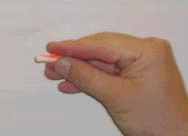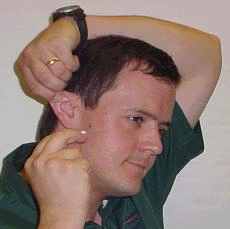UNIVERSITY OF WISCONSIN River Falls
Risk Management
Ear Plug Safety
Hearing protection is serious business. Occupational noise-induced hearing loss is 100% preventable through proper use of suitable ear protection when doing work that is noisy or when working near machinery that is noisy. What is “noisy”? Rule of Thumb : If you have to raise your voice to be understood by a person that you can reach out and touch with your thumb, you should wear hearing protection while doing the job or working near the source of the noise. If you are in noisy environments for long periods of time, or if the noise is extremely loud, noise monitoring may be needed to ensure you are not overexposed to noise while on the job. To evaluate the exposure and help address the problem contact Risk Management Office at 3344.
Sound Advice – Proper Insertion of Protective Foam Earplugs
This instruction sheet was created to provide a graphic guide to the proper procedure for insertion of foam earplugs. There are many different types of earplugs on the market, and one size does NOT fit all. If you need hearing protection, try a few different sizes and styles to find the one that fits you best – contact the Risk Managment Office for recommendations. Most of all: be sure you know how to use and care for the only gear that stands between you and a lifetime of ringing ears and diminished hearing ability.
|
|
Squeeze the plug along its length and roll it between your thumb and forefinger to compact it down for insertion into the ear canal. |
|
|
Do the “Hook n Grab” – Keeping the ear plug compressed and rolled, reach over and behind your head with your opposite hand and gently pull your ear slightly out and back to straighten out the ear canal and make insertion of the plug easier. |
|
|
Quickly insert the plug into the ear canal until it is deeply seated. You may have to keep a finger on the plug for a few seconds to let it expand to the size of your ear canal. Do not insert the plug so deeply that you cannot pinch a bit of the plug for removal – practice the insertion a few times in front of a mirror to get familiar with proper insertion depth. |
|
|
– Properly inserted earplugs will be easily visible from the sides, but only a very small portion of the plug will project from the ear. |
|
|
– Very little (if any) of the earplug should be visible from a straight-on view. If the plugs are hanging out of your ears like a couple of hot-air balloons, they are not going to be able to do their job as well as they should…and that means more noise for you! |
Back to Resources

















